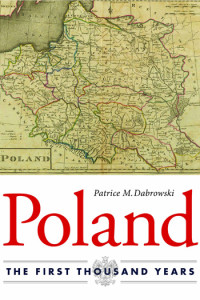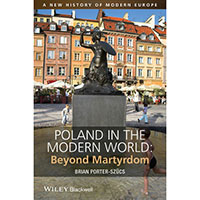 Poland: The First Thousand Years
Poland: The First Thousand Years
Patrice Dabrowski
DeKalb, IL: Northern Illinois University Press, 2014
487p. maps., ill., index.
The man known in his youth as Johann Heinrich de Panna Dąbrowski entered Polish history as General Jan Henryk Dąbrowski, immortalized in the lines of the chorus of what eventually became the Polish national anthem, “Marsz, marsz Dąbrowski/ z ziemiej włoskiej do Polski!” (March, march, Dąbrowski/ from Italian land[s] to Poland). In 1797, during the era of Napoleon’s ascent and militarization of the revolution in France, Dąbrowski formed the Polish Legion in French-held Lombardy, composed of émigrés from the recently dissolved Polish Commonwealth and Austrian prisoners of war. That the general “should come to be a universally acknowledged symbol of national defense among the Poles is somewhat paradoxical,” writes the contemporary American historian who shares his surname, Patrice Dabrowski. She notes that Dąbrowski’s mother was a Protestant of Scottish and German heritage; his father “a Pole who had served in the Saxon army.” The general himself had joined the Saxon army in the 1770s, had a Saxon wife, and his Polish was “not particularly fine” (298). Of course, the soldier’s poor Polish skills and mixed confessional and ethno-cultural heritage is only “somewhat paradoxical” if one views his Polishness from the present perspective, when Poland is largely a homogeneous state of Polish-speaking, culturally Roman Catholic people.

Gen. Jan Henryk Dąbrowski’s entry into Rome
Oil on canvas by January Suchodolski
Painted pre-1850
At the National Museum in Warsaw
Dabrowski’s masterful new survey of a thousand years of Polish history at once undercuts and reifies this perspective. The book is sensitive to the complexity of national identification, patiently reminding readers throughout the narrative that to be Polish in most periods was not tied to language or religion or even to what we think of as nationality, but rather to a sense of class and citizenship. Dabrowski acknowledges that as late as the early 1920s, many of the Catholic and Polish-speaking peasants of the new Polish state hardly saw themselves as Poles, identifying much more with their land and peasant worldview (392). She also underscores the ways in which in the nineteenth century, at least, many inhabitants of the partitioned territories could choose to be Poles, regardless of the origin of their surnames (359-362). One has no doubt that her concept of Polishness has room for the hero who shares her last name. And yet, Dabrowski’s decision to write a largely typical national history, one that begins with the first Polish kingdom and its monarch’s conversion to Catholicism, that often treats the history of Poland as the history of “the Poles”, and that ends with Poland as a fully-formed, homogeneous nation today, leaves room for readers to accept a narrower definition.
Poland: The First Thousand Years is a major achievement, lucidly and engagingly written. It should have a wide readership, from people with Polish heritage curious about the land of their forebears, to college students and fellow historians. Dabrowski capably guides the reader through a millennium of history of this admittedly complex and often forgotten multi-confessional and multi-ethnic region. A time-lapse map of European borders over the same period makes clear the complexity any historian taking on this subject would face, and Dabrowski handles the material beautifully, with deft pacing and prose. The text is grounded in the relevant scholarship in Polish and English, as well as primary documents, along with evocative examples from literature, art, and film. Excellent maps and a few photographs effectively illustrate the text. The Harvard-trained Dabrowski, who has worked and taught at a number of major institutions including UMass-Amherst, Brown, and currently, the University of Vienna, does an exceptional job of fitting Polish history into its broader European context. Readers learn what we might now call Prussian, Habsburg, and especially Ukrainian, Cossack, and Russian history, all while being treated to parallels or comparisons with examples in English, French, or even American history. The text offers a number of fresh interpretations of Polish history, including the author’s use of Jean-Jacques Rousseau’s Considerations of the Government of Poland (1772) as a key for her coverage of the partitions and Polish efforts to survive thereafter, in the nineteenth and twentieth centuries. Rousseau’s injunction “‘You may not prevent [ravenous neighbors] from gobbling you up; see to it at least that they will not be able to digest you,’” gives Dabrowski a leitmotif for discussing the ways that Poles made themselves “indigestible” in the years of imperial and Communist rule that followed (291). To call the various revolts and uprisings in the Polish lands in the ensuing years “hiccups” may seem a little out of place, but it lends overall coherence (433-34).
Yet for all its roots in cutting-edge scholarship and sensitivity to the complexity of self-identification, the book remains a traditional national history, with language at times redolent of such works. Dabrowski tends to personify Poland with feminine pronouns when the state is either a victim or acts nobly and to use the pronoun “it” when referring to the socialist variant of the state (see, for example, pp. 404, 441, 450). While Dabrowski is cautious about subscribing to the national myth wholesale, she doubtless sees one of her tasks in the book as a defense of the Polish contribution to western civilization, whether in the form of Sobieski’s defense of Vienna, the democratic system of Polish government in the Commonwealth, the novelty of the Constitution of the Third of May, or Piłsudski’s defense of Warsaw from “Soviet hordes” (389). Dabrowski writes about each of these topics, and many more, intelligently and persuasively. Each is a story worth being told. The problem, as I see it, arises when they are strung together, as if connected, into a single narrative. Any national history is fraught with the problem of becoming a teleology, a story that ineluctably arrives at its conclusion, and Poland: The First Thousand Years, is in its very title emblematic of this risk. The book begins with the founding of a state by king Mieszko and his conversion to Catholicism. “[T]he acceptance of Christianity by the Polish masses would shape the rest of Poland’s history,” Dabrowski writes, “to the extent that Poles are now generally considered to be among the world’s most devout Catholics and most devoted servants of the Holy See. This doubtless was the greatest legacy of Mieszko, the first of the Piast rulers” (22). Yet, later inhabitants of the Polish lands were not always or only Catholic, as Dabrowski’s text clearly shows. Jews, Protestants, Uniates, Greek Catholics, Orthodox Christians, and Muslims have called the Polish lands home. Describing the moment in the seventeenth century when Poland narrowly avoided partition after the Swedish Deluge, Dabrowski writes, “Yet this was not the right time—the right century—for such a move” (206). Later, while discussing the creation of a new Polish state after World War I, she notes: “The new Polish state had not only been born again—it had been creatively negotiated. World war had done its job” (383). While there is no doubt that there were many Polish speakers who were delighted with this outcome, it hardly seems sensitive to say that a war so destructive in the region “had done its job.” To write this is to take the long Polish perspective, rather than the perspective of the majority of the multiethnic peoples who had just survived the bloody conflict.
History, as they say, falls to the victors, and reading this book I kept wondering not about another greedy king, seeking “former Polish territories” as they do, but rather about the multiethnic burghers, the Jewish tavern-keepers, the Ruthenian or Mazovian peasants, the mothers and fathers whose homes were burned to the ground by marauding armies, in short, the people whose lives were often shattered by the machinations of the kings, magnates, and warriors who ruled them or attacked them from further afield. Seen over the perspective of a millennium, “the Poles” were as much victors as they were victims. Maybe that’s the sad upshot of national history: “Jeszcze Polska nie zginęła, póki my żyjemy” (Poland has not yet perished, so long as we still live) – and our story still gets told. This is not to say that this story does not warrant telling—it does, and Dabrowski has done it well—but rather to remind ourselves that victims can be victors, depending upon when the story starts and stops.
CR




Pingback: Welcome to our Spring 2015 issue!